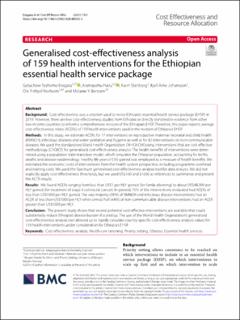| dc.contributor.author | Eregata, Getachew Teshome | |
| dc.contributor.author | Hailu, Alemayehu | |
| dc.contributor.author | Stenberg, Karin | |
| dc.contributor.author | Johansson, Kjell Arne | |
| dc.contributor.author | Norheim, Ole Frithjof | |
| dc.contributor.author | Bertram, Melanie Y. | |
| dc.date.accessioned | 2021-07-05T11:50:06Z | |
| dc.date.available | 2021-07-05T11:50:06Z | |
| dc.date.created | 2021-01-16T12:00:43Z | |
| dc.date.issued | 2021-01-06 | |
| dc.identifier.issn | 1478-7547 | |
| dc.identifier.uri | https://hdl.handle.net/11250/2763396 | |
| dc.description.abstract | Background: Cost effectiveness was a criterion used to revise Ethiopia’s essential health service package (EHSP) in 2019. However, there are few cost-effectiveness studies from Ethiopia or directly transferable evidence from other low-income countries to inform a comprehensive revision of the Ethiopian EHSP. Therefore, this paper reports average cost-effectiveness ratios (ACERs) of 159 health interventions used in the revision of Ethiopia’s EHSP.
Methods: In this study, we estimate ACERs for 77 interventions on reproductive maternal neonatal and child health (RMNCH), infectious diseases and water sanitation and hygiene as well as for 82 interventions on non-communicable diseases. We used the standardised World Health Organization (WHO) CHOosing Interventions that are cost effective methodology (CHOICE) for generalised cost-effectiveness analysis. The health benefits of interventions were determined using a population state-transition model, which simulates the Ethiopian population, accounting for births, deaths and disease epidemiology. Healthy life years (HLYs) gained was employed as a measure of health benefits. We estimated the economic costs of interventions from the health system perspective, including programme overhead and training costs. We used the Spectrum generalised cost-effectiveness analysis tool for data analysis. We did not explicitly apply cost-effectiveness thresholds, but we used USD 100 and USD 1000 as references to summarise and present the ACER results.
Results: We found ACERs ranging from less than USD 1 per HLY gained (for family planning) to about USD 48,000 per HLY gained (for treatment of stage 4 colorectal cancer). In general, 75% of the interventions evaluated had ACERs of less than USD 1000 per HLY gained. The vast majority (95%) of RMNCH and infectious disease interventions had an ACER of less than USD 1000 per HLY while almost half (44%) of non-communicable disease interventions had an ACER greater than USD 1000 per HLY.
Conclusion: The present study shows that several potential cost-effective interventions are available that could substantially reduce Ethiopia’s disease burden if scaled up. The use of the World Health Organization’s generalised cost-effectiveness analysis tool allowed us to rapidly calculate country-specific cost-effectiveness analysis values for 159 health interventions under consideration for Ethiopia’s EHSP. | en_US |
| dc.language.iso | eng | en_US |
| dc.publisher | BioMed Central | en_US |
| dc.rights | Navngivelse 4.0 Internasjonal | * |
| dc.rights.uri | http://creativecommons.org/licenses/by/4.0/deed.no | * |
| dc.title | Generalised cost-effectiveness analysis of 159 health interventions for the Ethiopian essential health service package | en_US |
| dc.type | Journal article | en_US |
| dc.type | Peer reviewed | en_US |
| dc.description.version | publishedVersion | en_US |
| dc.rights.holder | Copyright the authors | en_US |
| dc.source.articlenumber | 2 | en_US |
| cristin.ispublished | true | |
| cristin.fulltext | original | |
| cristin.qualitycode | 1 | |
| dc.identifier.doi | 10.1186/s12962-020-00255-3 | |
| dc.identifier.cristin | 1872498 | |
| dc.source.journal | Cost Effectiveness and Resource Allocation | en_US |
| dc.identifier.citation | Cost Effectiveness and Resource Allocation. 2021, 19, 2. | en_US |
| dc.source.volume | 19 | en_US |

